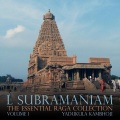
The Essential Raga Collection, Vol. I (Yadukula Kambhoji)
Yadukula Kambhoji is a very old, traditional raga of Carnatic music. In the early days, it was popular in the Tamil tradition (as sevvazhi pann) and entered mainstream Carnatic music only much later, mainly due to the exquisite compositions of Shyama Shastry, Tyagaraja, and Muthuswami Dikshitar. Several other composers like Subbaraya Shastry, Gopalakrishna Bharati, Swati Tirunal, Veena Kuppier, and Papanasam Sivan have also composed in Yadukula Kambhoji raga. According to one source, Shyama Shastry is said to have spontaneously created this raga during one of his practice sessions. Apparently the great composer was singing a raga alaapana in the raga Kambhoji when he heard a shepherd boy sing a folk tune. The beautiful blend of the Kambhoji raga alaapana with the folk song of the shepherd inspired Shyama Shastry to compose a swarajati in Yadukula Kambhoji. Later, he is said to have visited Tyagaraja to share his swarajati with him. Tyagaraja was so impressed with the raga and the composition that he is said to have composed a song himself. Later he composed 4-5 kritis in the raga. Yadukula Kambhoji is a derived from the melakartha raga #28, Harikambhoji. In the arohana (ascent) it has the notes S R2 M1 P D2 Ṡ (tonic, major second, perfect fourth, perfect fifth, major sixth, octave) and in the avarohana (descent) it has the notes Ṡ N2 D2 P M1 G3 R2 S (octave, minor seventh, major sixth, perfect fifth, perfect fourth, major third, major second, tonic). The album starts off with "Kamalakshi ninne kori", a varnam composed by the great composer and veena player Kuppier. It is set to a 14 beat cycle called Kanda jati Atta tala. This is a technically complex piece performed by Dr. Subramaniam in multiple speeds, by diving the beat into different pulses. The second piece is a short raga alaapana, a free style improvisation that introduces the raga. The alaapana is usually performed before the beginning of a composition. The raga alaapana is followed by "Nee dayache rama", a kriti composed by Tyagaraja set to Adi tala of 8 beats. This kriti is in praise of lord Rama, the hero of the epic Ramaayana. The concluding piece is Muthuswami Dikshitar's "Divaakara tanujam shanaishvaram", a kriti which is a part of his famous navagraha kritis series. This composition is in praise of lord Shaneeshwara, the embodiment of the planet Saturn and deity of the seventh day in the Indian calendar, Saturday. Dr. L. Subramaniam, India's foremost violinist began learning the violin at a very young age from his father Prof. V. Lakshminarayana. His guru-shishya parampara can be traced back to the three greatest composers of the Carnatic music tradition - Shyama Shastry, Tyagaraja, and Muthuswami Dikshitar. He started performing Carnatic (South Indian classical) music at the age of six and soon gained immense popularity playing with his brothers in the Violin Trio. Even as a teenager he took a great interest in different forms of music and attained mastery over Western classical violin as well. Over the years, he has created the Global Fusion idiom and composed several crossover orchestral works but his primary focus has been Carnatic music. His mastery over technique, his sensitive musicianship and his intellectual innovations have enthralled audiences around the world. He has performed in all continents and is largely responsible for the international status that Carnatic music enjoys today. In his glittering career spanning over five decades, he has several innovations to his credit, including playing a varnam in 15 speeds, playing a pallavi in a rhythmic cycle of 21 3/4 beats, and improvising in pancha nadai (by dividing a beat into different pulses). This album is the first in the series of "The Essential Raga Collection" - albums that Dr. Subramaniam has dedicated to the exposition of a single raga.
专辑歌曲列表
-
印度语 大小:12.3 MB
-
印度语 大小:6.56 MB
-
印度语 大小:25 MB
-
印度语 大小:9.03 MB


